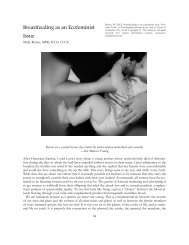RE:IJSNC, Issue 1, Volume 2, May 2012 - Ocean Seminary College
RE:IJSNC, Issue 1, Volume 2, May 2012 - Ocean Seminary College
RE:IJSNC, Issue 1, Volume 2, May 2012 - Ocean Seminary College
You also want an ePaper? Increase the reach of your titles
YUMPU automatically turns print PDFs into web optimized ePapers that Google loves.
Restoration Earth: An Interdisciplinary Journal for the Study of Nature & Civilization, 1(2)<br />
other, and reaching out via internet discussions, 11<br />
this is just a beginning as women also need to heal<br />
their relationships with the internalized feminine<br />
and likewise with other women. The desire to<br />
reach out is generally motivated by an image of<br />
women as caring, nurturing and such. It does not<br />
address the deeper power—hidden in the shadowed<br />
inner realms. The power that arises as we<br />
connect with Nature, Mother Earth, will assure the<br />
needed changes.<br />
First, women need to embark on that deeper<br />
journey in order to clear the patriarchal forces<br />
within themselves. This is a necessary step if we are<br />
to free ourselves from interjected and internal destructive<br />
behaviors (Mijares, Rafea, & Angha,<br />
2011). This requires an inner journey—one where<br />
we learn to sense our way through dark emotions<br />
and motivations deep within unconscious realms.<br />
As we become more aware of neurological sensations<br />
and intuitively recognize what is behind<br />
them, we can heal our relationship with our inner<br />
feminine—an awareness that is greatly assisted by<br />
breathing processes (Mijares, 2009).<br />
The interjected patriarchal forces show up as<br />
repressive conditions and internalized voices<br />
within consciousness. For example, an unconscious<br />
masculine part of oneself can demean the<br />
unconscious feminine, causing her to believe, on<br />
an inner level, that she is unworthy or doesn‘t<br />
know what she believes. This then impairs outer<br />
relationships as the woman may project this pattern<br />
on other women in order to feel better about<br />
herself. When this internal programming is recognized<br />
at psychosomatic levels, the pattern can be<br />
changed.<br />
A recent article in Harper’s magazine noted how<br />
generations of feminists have failed to connect<br />
with one another, thereby weakening what each<br />
generation has contributed. According to the research<br />
by its author, each generation tends to emphasize<br />
a different direction, thereby undermining<br />
and criticizing the work before and after, and confusing<br />
definitions of feminine nature (Faludi,<br />
2010). The author’s point was that this was a form<br />
of matricide. As long as there is a psychic split<br />
within the relational feminine, we cannot bring<br />
forth our innate power, this power to move mountains.<br />
We need to reconcile differences, and build<br />
28<br />
on one another’s contributions—from Enheduanna’s<br />
stories of Inanna through feminists of all eras<br />
(Dalglish, 2000; Dalglish, 2008), and all those who<br />
work for gender balance.<br />
Generations of women have both held and passed<br />
on an internal psychic split. Given that the mother is<br />
generally the initial relationship, the newborn feminine<br />
self is psychically influenced by the mother’s<br />
experience at a cellular level. Most likely, the imprinted<br />
message from the last five to six thousand<br />
years of patriarchal ideology and behaviors has been<br />
passed on (consciously or unconsciously), the message<br />
that the feminine self is inferior. Also, the<br />
mother has her moods, like the changing moon, as<br />
does Mother Earth Herself, evidenced in storms,<br />
floods, rains and sunny days.<br />
According to psychoanalytical perspectives, an unconscious<br />
split occurs in those who cannot hold the<br />
changes taking place in the mother and/or the environment.<br />
If there is trauma or the mother does not<br />
provide essential nurturing, the split is exacerbated.<br />
Psychoanalysts call this the “good mother”/”bad<br />
mother” split. So this equates to an internalized<br />
“good woman”/”bad woman” split.<br />
In the Introduction to A Force Such as the World Has<br />
Never Known (in press), I wrote how:<br />
One also sees this split encouraged in religious<br />
tales, such as the “virgin” rendition of<br />
the birth of Jesus, similar myths related to<br />
Guatama Buddha’s birth as well as the births<br />
of other historical male figures. The virgin<br />
(which actually means someone who is whole<br />
in herself) is distorted to represent a woman<br />
who is sexless (and whose only role is to be a<br />
“pure” vehicle to birth great men). Other<br />
women then end up holding the projected<br />
opposite—the whore, the bitch, the demon<br />
figure (and in many fairy tales she is also depicted<br />
as the “wicked stepmother”). (Mijares,<br />
Rafea, & Angha, in press)<br />
Consider the numerous women who are unable to<br />
get along with one another. They are acting out these<br />
archetypal influences, diminishing another woman or<br />
negating her accomplishments because of envy and<br />
the deeply felt sense of incompleteness. Many<br />
women dominate or demean others in misbegotten<br />
attempts to feel important. Envy is based on a false<br />
idea of inferiority. Thus “when we are unable to rec-



